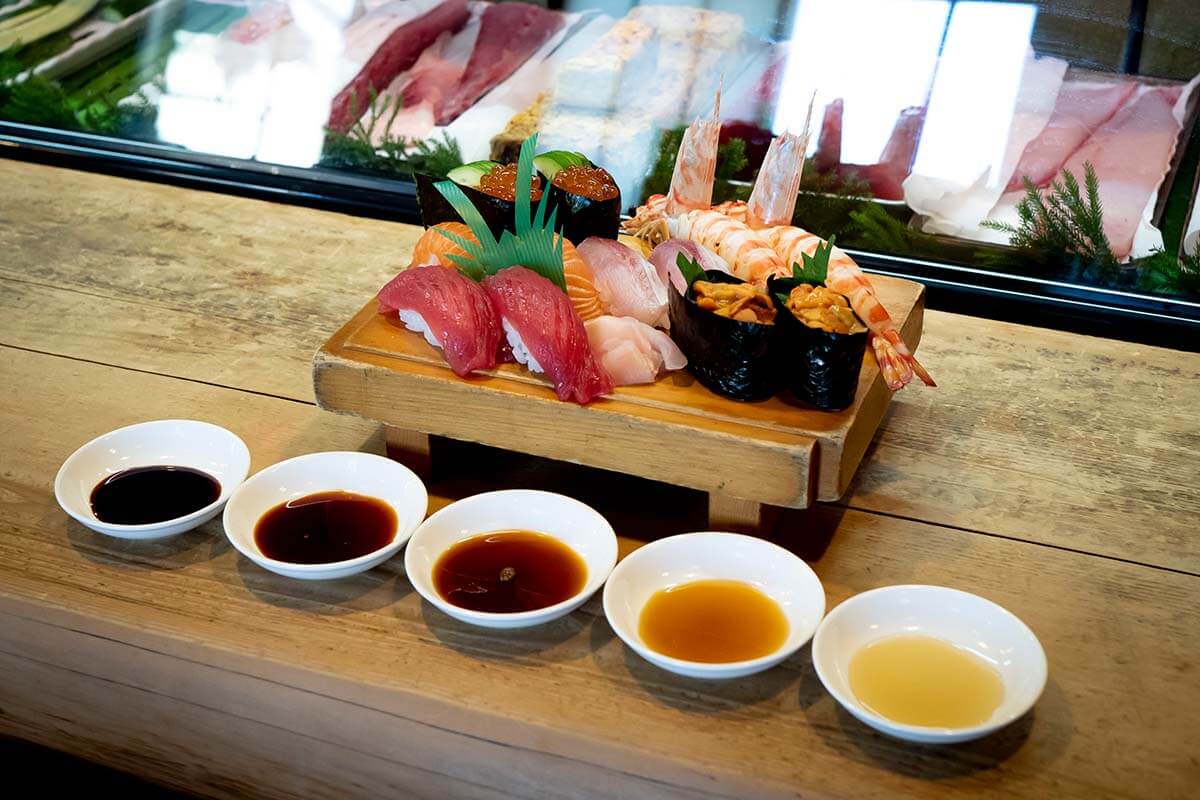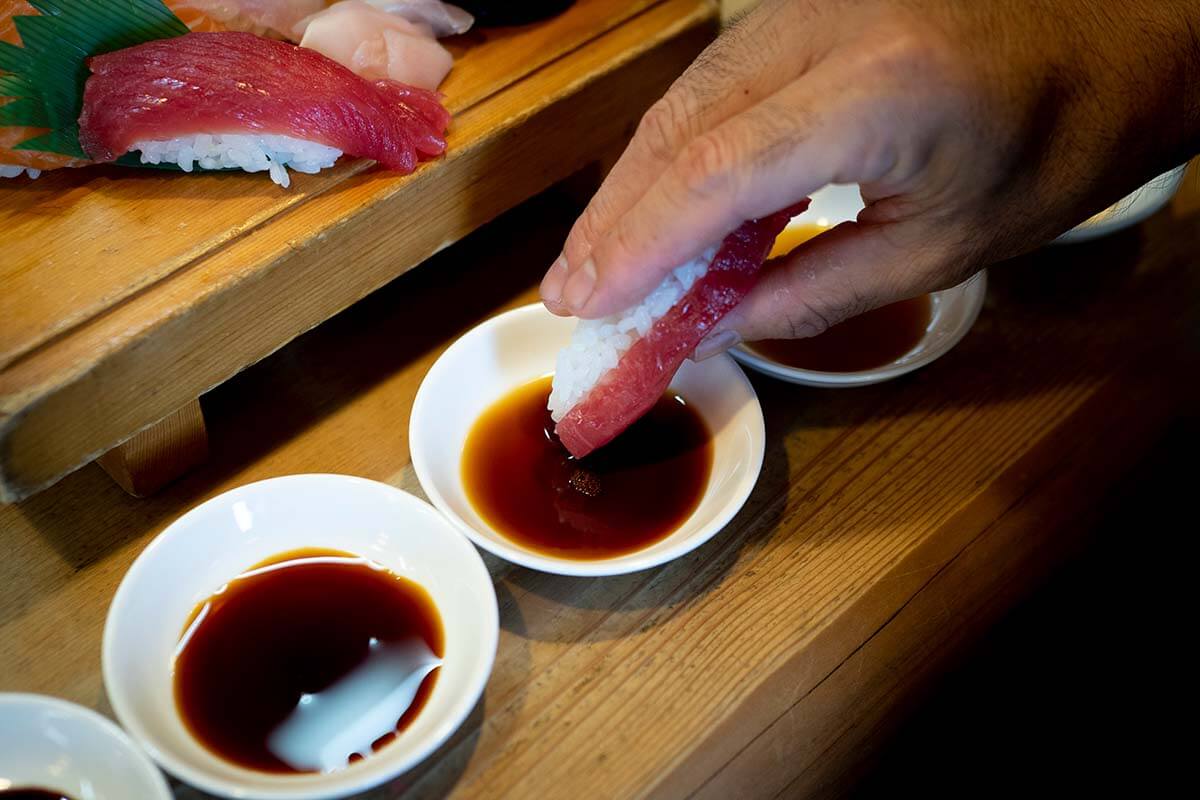Nigirizushi
Last October, American food professionals visited fermented food producers to deepen their knowledge of Japanese fermentation culture during the “Hakko Tourism in Japan” tour campaign. As part of the tour, organizers held a tasting session where guests gave candid advice from the perspective of the American market to food product manufacturers looking to enter the United States market.
Nigirizushi is one of the most popular Japanese foods in the world.
Nigirizushi, which is made by placing ingredients (mainly seafood) on top of shari (vinegared rice), was born in the late Edo period (the early 1800s) in the city of Edo (present day Tokyo). At that time, yatai (stalls) was very popular in the city of Edo, and it became popular as fast food that could be eaten as soon as it was made.
For me, an ordinary person who grew up in the countryside of Japan, nigirizushi is a special thing.
When I was a child, nigirizushi was not an everyday dish. Instead, it only appeared on special occasions such as annual family and relative gatherings. My grandmother’s heartfelt welcome and love took shape in the form of nigirizushi. Even though the number of casual sushi restaurants has increased and nigirizushi is available even at supermarkets today, my heart still feels warm whenever I see nigirizushi, recalling the lively voices and smiling faces of my family.
I’m now in the business of introducing people to soy sauce, and a question that I get asked the most by soy sauce users is “what type of soy sauce goes best with sushi and sashimi?” However, I also ask myself “Sushi is often served with rich soy sauce, but shouldn’t it depend on the ingredients of the sushi?”
So I compared the taste of tuna, salmon, hamachi, shrimp, sea urchin, and salmon roe, which are popular sushi items in the US, using five different types of soy sauce: shiro (white), usu-kuchi (light color), koi-kuchi (dark color), sai-shikomi (double-brewed), and tamari.
I chose soy sauces with the most typical and popular flavor to make this as helpful as possible. The usu-kuchi and koi-kuchi types were from major brands. The shiro, sai-shikomi, and tamari types were the ones with the fewest peculiarities. Overall, I compared the flavors using soy sauces that had clean and elegant tastes.

Tuna
Tuna has a smooth texture that sticks to your tongue. Soy sauce with a deep flavor goes well with the slightly iron-flavored acidity and the deep flavor of tuna. Especially when combined with sai-shikomi soy sauce, the taste is broadened, and a wonderful harmony of flavors arises. When combined with tamari soy sauce, the astringent taste unique to tamari soy sauce provides a good impact and makes the taste addictive. With the shiro, usu-kuchi, and koi-kuchi flavors, the soy sauce lost out as I chewed, and it was almost as if I could taste only the tuna.
Salmon
Salmon is a combination of thick meat and fat similar to that of a marbled wagyu beef that melts on your tongue, and it goes well with the strong flavor of sai-shikomi soy sauce, and the strong saltiness of usu-kuchi soy sauce. If you taste it with sai-shikomi soy sauce, then you will be captivated by its rich and colorful taste. If you taste it with usu-kuchi soy sauce, then the sweetness and flavor of the salmon will be enhanced and the aftertaste will be refreshing. Shiro soy sauce and sai-shikomi soy sauce lose out to the salmon, while the tamari soy sauce gives the sensation of breaking up the flavor.
Hamachi
Koi-kuchi soy sauce and sai-shikomi soy sauce, which are excellent at balancing the five flavors, go well with hamachi, which has a firm and springy texture, a good amount of fat, and a delicate flavor that spreads to the palate as you chew. When tasted with koi-kuchi soy sauce, the delicate flavor of the hamachi is amplified in your mouth, and with sai-shikomi soy sauce, the balance of flavors is enhanced and the taste is powerful and mellow.
Shrimp
Koi-kuchi soy sauce and usu-kuchi soy sauce go well with shrimp, which has a crunchy texture, a refined flavor, and a sweetness that radiates from every bite. When you taste it with koi-kuchi soy sauce, the sweet and savory flavors of both soy sauce and shrimp combine as you bite into it, creating a rich taste. When tasted with usu-kuchi soy sauce, the delicate sweet aroma and flavor of the shrimp expand.

Sea Urchin
The texture is so smooth that it softly melts on the tongue. The taste is so rich that one bite will fill your heart. Usu-kuchi soy sauce, which also has a salty flavor, goes well with sea urchin. The seaweed, rice, and sea urchin loosen up in your mouth, and as you chew, the saltiness of the usu-kuchi soy sauce enhances the flavor of the seaweed and the rice and perfectly balances the saltiness of the sea urchin. It also has a refreshing aftertaste. Shiro soy sauce, its special characteristic being saltiness and sweetness, gives it a humorous sweetness, while koi-kuchi soy sauce gives it a richer flavor. However, sai-shikomi soy sauce gave it a sour taste, and tamari soy sauce gave it an uneven-feeling taste.
Salmon Roe
Every time you bite into it, the sweet, savory, and salty flavors of the salmon roe come out in a burst of flavor. Since the salmon roe is already marinated in soy sauce and the texture and flavor have a strong impact, it’s hard to tell the difference when comparing soy sauces because the impression of the soy sauce is diminished, but koi-kuchi soy sauce and usu-kuchi soy sauce go well with salmon roe. With koi-kuchi soy sauce, the soy sauce brings out the flavor of the rice, and with usu-kuchi soy sauce, the soy sauce enhances the flavor of the rice and the seaweed, creating a perfect harmony with the impact of the salmon roe. Sai-shikomi soy sauce and tamari soy sauce are too rich in flavor and create a heavy feeling.
Please note that the flavors of koi-kuchi soy sauce and tamari soy sauce vary widely from one brewer to another and using a different tamari soy sauce could yield a completely different result.
In conclusion, generally the best matched soy sauce vary depending on the sushi. Light-flavored sushi goes well with light-flavored soy sauce, whereas sushi with a strong flavor goes well with darker soy sauce. I also recommend adding a little bit of koi-kuchi soy sauce or usu-kuchi soy sauce to salty sushi. Hope you enjoy tasting different kinds of sushi with different kinds of soy sauce using this article as one of your references.
Keiko Kuroshima, the world's first soy sauce sommelier and certified sensory inspector, hails from Japan's soy sauce production hub in Shodoshima. She co-authored a book on the island's breweries and is the only female among the three soy sauce sommeliers worldwide. Her expertise and passion elevate soy sauce appreciation globally.

